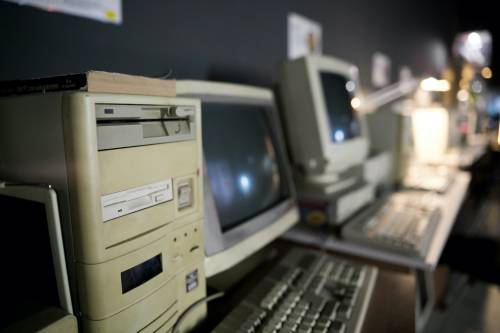
We are noticing an increase in the number of collections we are making from the 24hr storage facilities that have become a common sight on any city centre journey. They may just provide you with the secure, flexible and readily available solution for the next large scale equipment roll out you have planned, or give you that extra bit of room needed when logging the equipment for removal from your asset register.
First of all they targeted the people with too much stuff; all those keepsakes we need to fill our lives with andjust can’t bear to part with. Then traders started to use these as a secure version of Del Boy’s lock-up. With its 24hr CCTV and secure entrance to the building, the big padlock of the door still needed to be beaten, even if anyone had made it to your unit. The rise of reliable mobile broadband then began a new chapter in the story of secure storage, the start up company. Using the locker as storage and an office, all you needed was a chair a desk and a mobile phone.
Examples of Storage Unit Waste Collections
We have collected from these units’ dozens of times over the years, but the last 18 months has seen an increase in the frequency of these collections.
We decided to ask a couple of our clients why?
- A County wide service provider used a secure storage unit next to a main road through the county. IT engineers could use the container for the redundant equipment they collected. The opportunity to frequently visit the centrally based container, to exchange faulty items, and leave equipment away from prying eyes meant a reduction in equipment being left on-site and getting damaged, and also reduced the opportunity of a data breach. When the container was filling up, we received the call to meet an engineer on site. We then collected the redundant equipment all in one go, reducing our collection fees. The short trip from the container to the vanalso gave us one happy driver due to the fact they had no stairs to climb.
- A large nationwide company, with lots of locations told us it was because many of their offices were in older buildings spread across the city. They could arrange for the new equipment roll out of monitors, PCs and printers across their network to be delivered in one go, to one central location. The secure depot was selected for its loading bay access, meaning the equipment was rolled off the lorry and into two large storage units. A third unit next door was also booked. With the equipment unpacked and booked in, mobile engineers were then called to the unit to collect each day’s equipment roll out. Returning at the end of the day with the old equipment. Booking into the third container, the equipment had serial numbers and asset tags taken and the cycle repeated itself for the next couple of weeks. When they had finished the roll out, they were back down to two units with one full of cardboard and packaging, and the other was full of printers, screens (re-boxed) and systems, which were all logged.

We were then called into action, and asked to come and collect. Thirty yards from the storage unit we parked two vans on the loading bay, ideal for a swift getaway. We had another driver en-route and two more to follow them, with the third driver arriving one of the loaders left with the first van, driver number four already on his way and driver five good to go, this gave the storage company plenty of room in their yard, having five vehicles all trying to get loaded could have interfered with everybody else’s day. Driver two left for home leaving numbers three and four loading, the relay continued when driver five arrived to collect the last of the items in the unit. Driver number one had made it back and was now booking in, and 4 more vans of equipment heading to our processing unit. Having loaded the vans with the same equipment type, the steady stream of equipment landing at our warehouse made booking in an easy process, with pallets full of systems, TFTs and printers floating up to the shelves. Five vans and six ton of equipment moved from site an hour away to our unit in six hours.
A job well done? Our client was pleased with the service we delivered, and our booking in process gave them the ability to quickly match our inventory against their own. The lack of stairs and multiple pickups gave us a speedy getaway from the storage unit after loading in the blink of an eye. Whilst every effort is made by the storage company to keep the site secure, the security on this occasion had not been approved by ADISA.
So it may not be the ideal place to store your equipment after all. But it did work perfectly for both of the examples given here. The data protection act, suggests you give your redundant data the same standard of security as you do to your live data. So using this type of storage DOES have a risk when it comes to your data, is it a risk worth taking, only you know the value of your data.
